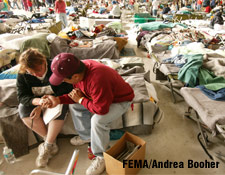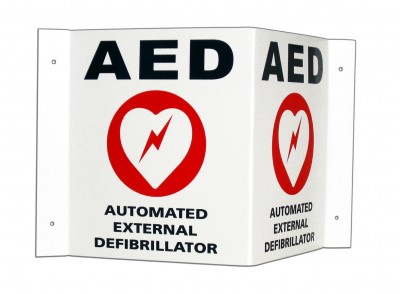
Eventually, we all reach EMS satori — I’m referring, of course, to the realization that most of our job doesn’t involve saving lives, or performing any high-level, acute medical interventions. Once we understand this, the question becomes: what does our job consist of?
One good answer among many is the management of psychological rather than physical injury. Can we help the person, even when there’s little need to help the body? We sure can, and it seems like after all the hours we spent studying airway management, we should spend at least a little time developing this other skill. If we’re going to surrender our identity as ET tube samurai, we’d better become experts at dropping mental balms.
It may not be rocket science, but there is certainly a right and a wrong way to help. One good source of ideas for doing it the right way is called psychological first aid.
Psychological first aid, or PFA, is a system developed jointly by the National Child Traumatic Stress Network and the National Center for PTSD. It’s meant to be a psychological counterpart to medical first aid — not a replacement for long-term professional therapy, but merely a method for addressing the immediate, acute mental stress response following crisis. It’s largely aimed at post-disaster scenarios, such as the victims of hurricanes and mass casualty incidents, and it’s become the preferred methodology for American Red Cross personnel. However, it also has valuable concepts that we can use every day on the ambulance, to help us care for both patients and any of their family or friends who are struggling.
This sort of thing may come naturally to some people, but PFA rolls it together into a standalone curriculum that can be transmitted to any professional, particularly those of us who don’t specialize in mental health. It’s also evidence-based: there is research behind most of its interventions, and the science tells us that it generally works. (Contrast this to CISM, which many feel is baseless at best and counterproductive at worst.)
Classes are available; check with your local Red Cross for more information. But here are some of the concepts:
General ideas
- Take your cues from the patient. If they want to talk, listen. If they don’t, don’t force them.
- You’re here as support and to listen, not as Dear Abby; limit your input and resist the urge to offer advice. Be sparing with relating personal anecdotes or “war stories,” even if they seem germane; it’s the patient’s crisis, not yours.
- Cater your approach to the patient’s age and culture. Children in particular will need a different style than adolescents and adults. When approaching children, make contact with parents first, and understand that both parties will probably need to be attended to.
- Reassure them that their emotions and reactions, no matter what they may be, are understandable and acceptable, not pathological.
- Use language that’s clear, simple, and personal, avoiding medical terminology or jargon.
- Understand your own role and limitations, and be ready to bring in better-trained specialists.
Avoid these types of remarks:
- I know how you feel.
- It was probably for the best.
- She is better off now.
- It was his time to go.
- Let’s talk about something else.
- You should work towards getting over this.
- You are strong enough to deal with this.
- You should be glad she passed quickly.
- That which doesn’t kill us makes us stronger.
- You’ll feel better soon.
- You did everything you could.
- You need to grieve.
- You need to relax.
- It’s good that you are alive.
- It’s good that no one else died.
Major Goals
1. Contact and Engagement
As you go about the business of the call, make sure that you’re orienting yourself as somebody who’s willing and able to help. From the initial patient contact all the way until you shake hands and part ways, you should be presenting yourself as a compassionate professional; all it takes is one slip of the tongue or roll of the eyes to betray that you’d rather be back at quarters finishing your burrito.
2. Safety and Comfort
Obviously, you should ensure that you are both physically safe, and that immediate medical concerns are managed; this also includes the recognition of patients who could harm themselves or others (like you).
If you’re still at a scene or in the ED where upsetting things are happening (such as a resuscitation), try to move somewhere more quiet and controlled. Keep them physically comfortable, with blankets, a chair, food or water, etc. Remove them from anyone who is themselves panicked or emotionally distressed, but do help to put them in contact with social support, such as friends, family, or clergy.
Try to give people active, familiar things to do, rather than sitting there passively being overwhelmed. Anything, even minor tasks (“here, hold this”), that involve them with their own care or the care of their loved one is beneficial; perhaps they can make some phone calls or locate insurance information.
Share whatever information you have regarding what’s currently happening, including what’s happening to others affected, and what can be expected next (do use judgment on how much they want/need to hear at this stage, though). But don’t lie, guess, form unfounded predictions, or make promises beyond your control (“they’ll/you’ll be just fine”). Consider a broad interrogatory like “Is there anything else you’d like to know?”
Kids may appreciate something like a teddy bear, and you can use it as a proxy for their own care, for instance: “Remember that she needs to drink lots of water and eat three meals a day — and you can do that too.” Also, children especially are sensitive to alarming sights and sounds; try to shelter them from unnecessary stimuli.
3. Stabilization (if needed)
As we’ve talked about before, anyone experiencing an acute, uncontrolled emotional response needs to be stabilized and grounded before much else can be done. Be on the lookout for things like: glassy-eyed or vacant stares; aimless wandering or unresponsiveness; uncontrolled crying, hyperventilating, shaking, or rocking; or frantic, illogical, even potentially dangerous behavior such as perseverating on simple tasks (continuously searching for a pair of glasses) or walking thoughtlessly through traffic. Remember that reactions may ebb and flow in surges.
Rather than broad reassurances — “stay calm” — try to determine their specific concerns, even if not entirely rational, and help address them. If completely adrift, patients may be assisted in “grounding” by deep breathing and asking them to describe where they are or concrete aspects of their surroundings (I see a table, I see a clipboard).
Consider both giving them some brief privacy (do tell them when you’ll be back), and remaining present and available yet non-intrusive, such as sitting nearby while you finish paperwork.
4. Information Gathering: Current Needs and Concerns
Determine the specific problems and needs of the patient. Individual responses may be flavored by their own psychological backdrop (such as depression or anxiety), history of similar incidents (a prior MVA or death in the family), or other unpredictable elements (they can’t stand the waiting room music). In some cases, the need for referral to a specialist may become obvious here, such as uncontrolled schizophrenia or major stressors in the setting of known PTSD and a history of self-harm; don’t try to “wing it” in complex psychiatric cases.
Follow their lead, and don’t press for details — a CISD-type debriefing can come later, if appropriate. Listen actively and openly. Look for expressions of emotion in their remarks, then make clarifying comments such as: “It sounds like you’re being really hard on yourself about what happened” or “It seems like you feel that you could have done more.” No matter what, don’t judge.
5. Practical Assistance
Assist the patient with any practical issues, which may be dominating (or over-dominating) their attention. Offer to notify friends or family, arrange for needed support, or obtain information about their care. Larger needs (such as questions about the costs of treatment) may be beyond your immediate power to address, but you can often take the first step, such as notifying hospital staff of their concerns. At the very least, provide whatever information you can and discuss a plan for resolving the problem. Even small measures like a warm blanket can have both practical and psychological benefit.
Remember that, although you may not be the most knowledgable or appropriate resource for many concerns, as an EMS provider you may be the only person who has the time and ability to address them. If you don’t make that phone call or find them a glass of water, it may be a long time until anybody else does; and it may not seem like a priority to find someone to move their car, but imagine how much better they’ll feel after it gets ticketed and towed.
6. Connection with Social Supports
Make an effort to enlist the patient’s support structure. In some cases, the first step may be to actually ask some version of, “Do you have a support network?” Some patients, such as the elderly or homeless, may not, and may need to rely particularly on institutional support, such as social workers.
When multiple individuals are in a group, such as family members at a scene or in the waiting room, ask if they have any questions or requests; this can provide a jumping-off point for further communication.
Make particular effort to bring children together with their parents or caregivers, and try not to separate them unnecessarily. Consider engaging children with simple activities, such as tic-tac-toe, “air hockey” (wad up paper and try to blow it across a table into the opposing person’s “goal”; this also promotes deep breathing), or the scribble game (one person scribbles on a paper, and the other tries to make it into something coherent).
7. Information on Coping
This step focuses on describing common stress reactions so that individuals will be more equipped to manage them. It is probably best left to more specialized professionals, since our own training is usually limited here.
8. Linkage with Collaborative Services
Help pass the patient along to existing resources, either by providing contact information or through direct referral. Most hospitals will have phone numbers or extensions for mental health, social work, counseling, and other services, and there are hotlines available for individuals not in care at a facility. (It’s worth having this sort of thing in your phone or on a cheat sheet, so that it’s available when you need it.)
When bringing in other aid, and even when making routine hand-offs to ED staff and the like, try to smooth the transition of care. Patients often feel as if they are passing through the hands of an endless series of personnel, with each one demanding to hear their story (and probably take their vital signs). Make an effort to give full, complete reports, and to establish your credibility through word and deed so that receiving staff feel less of a need to do it all over again; in particular, try to communicate whatever concerns or emotional state the patient is currently experiencing, so that the job of managing it can be seamlessly turned over. Introduce the new “helper” (for instance, the RN) directly to the patient, and let them know that they’ll be taking care of them; don’t just disappear, or they may feel abandoned.
Further information can be downloaded here from the National Center for PTSD.



Recent Comments